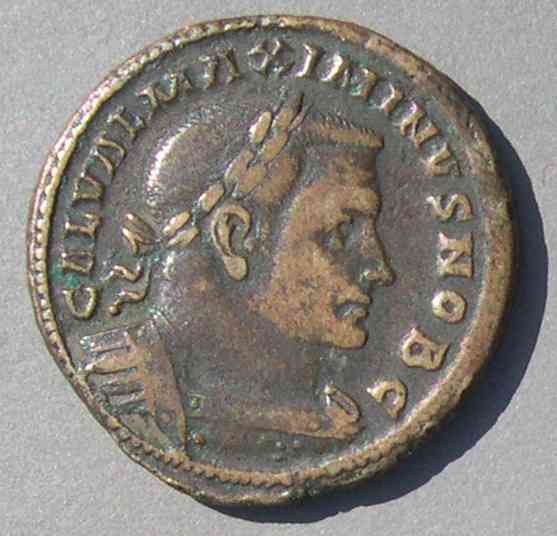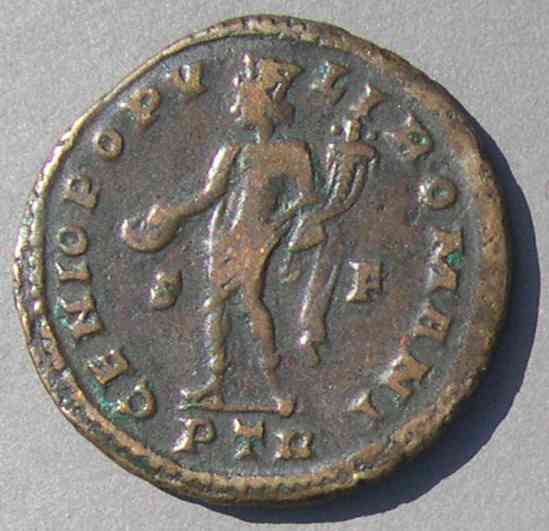Constantine as Caesar and as FIL AVG (A.D. 306-310)

A copper coin of Constantine the Great with the title "FIL AVG."
It is 24 mm in diameter and 6.03 grams. It is a "follis," and was struck in 309 AD at Antioch.
by Warren Esty, copyright 1997-2023. This article originally appeared as the cover article in The Celator, September, 1997.
It has been modified with additional photos and comments.
(Skip down to the table listing all the FIL AVG types which is followed by the pictures of coins with FIL AVG.)
(Skip down to the Second Tetrarchy or the Carnuntum decisions.)
The Caesar Constantine took the title Augustus in the West in 307 without the consent of the East. Before the East also recognized him as Augustus he was awarded by Galerius the ephemeral imperial title Filius Augusti, "Son of the Augusti." "FIL AVG" and "FIL AVGG" appear only on coins of Constantine and Maximinus II, and, because both rejected the title, only on coins issued in their names from mints they did not control. The story begins in the context of the tetrarchic system in July 306 when the western Augustus Constantius I, terminally ill, gave his son Constantine imperial power. It ends in mid 310 when events forced the eastern Augustus Galerius to recognize Constantine and Maximinus II as Augusti. Coins illustrate the complicated power struggle during these four years.1
The first tetrarchy was a new governmental system for sharing power that was created by Diocletian. After becoming emperor in 284, Diocletian chose a colleague, Maximian, to rule in the West in 286. Diocletian associated himself with the god Jupiter and Maximian with Hercules. To distinguish Maximian from other rulers with very similar names, he is sometimes called Herculius.2 The first tetrarchy originated in 293 when each Augustus took a junior ruler, a Caesar, as an associate, to make a total of four simultaneous rulers (tetra means four in Greek, arches means ruler ). Constantius became Caesar in the West and Galerius became Caesar in the East.3 These two new rulers were not sons, or even close relatives, of the Augusti. At this stage the Jovian and Herculian dynasties relied on adoption of highly-qualified candidates who were then married into the dynasty.4
The First Tetrarchy (293-305). It began when Constantius and Galerius were made Caesars.
| First Tetrarchy | West | East |
| Augustus | Maximian | Diocletian |
| Caesar | Constantius | Galerius |
Mints in both East and West respectfully struck coins in the names of all four colleagues. There is a page on coins of the First Tetrarchy.
The second tetrarchy began with the retirements of Diocletian (Coin 1A) and Maximian (Coin 1B) in 305 and the simultaneous elevation of Constantius and Galerius (Coin 1) to Augusti and the creation of Severus II as western Caesar and Maximinus II as eastern Caesar.
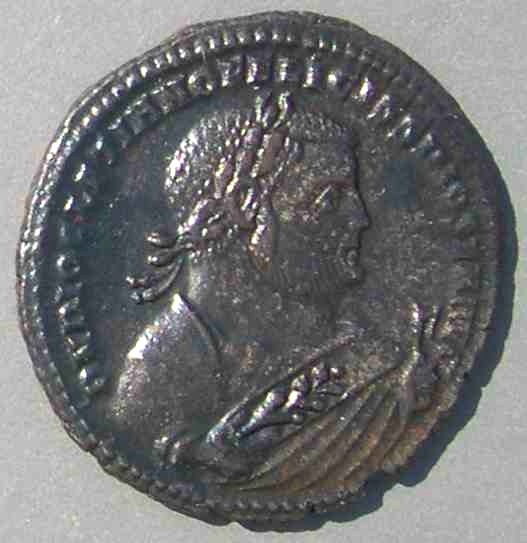

Coin 1A
Diocletian, who retired in 305 AD.
27 mm. 12:00.
Struck May 305 to early 307 at Trier.
DN DIOCLETIANO FELISSIMO SEN AVG
"SEN" for SENior, retired, augustus.
PROVIDENTIA DEORVM QVIES AVGG
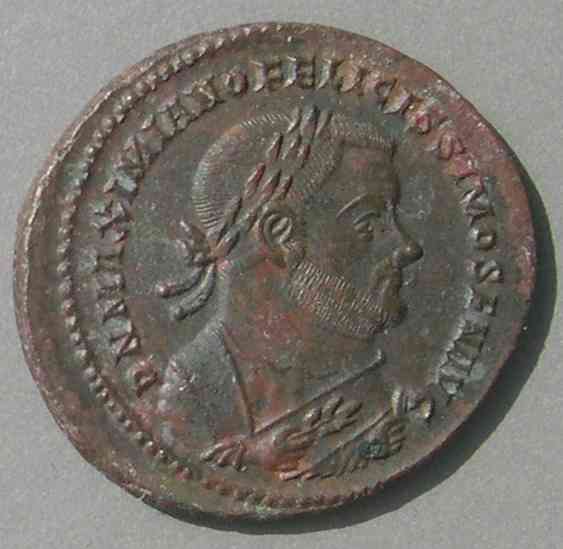
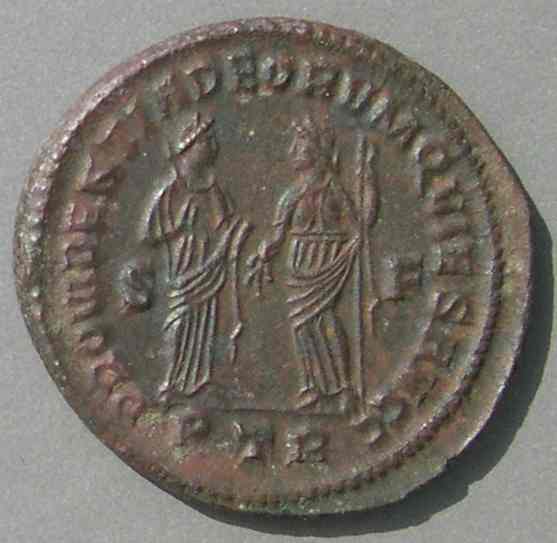 Coin 1B
Coin 1B
27 mm.
Struck May 305 - early 307 at Trier.
DN MAXIMIANO FELICISSIMO SEN AVG
PROVIDENTIA DEORVM QVIES AVGG
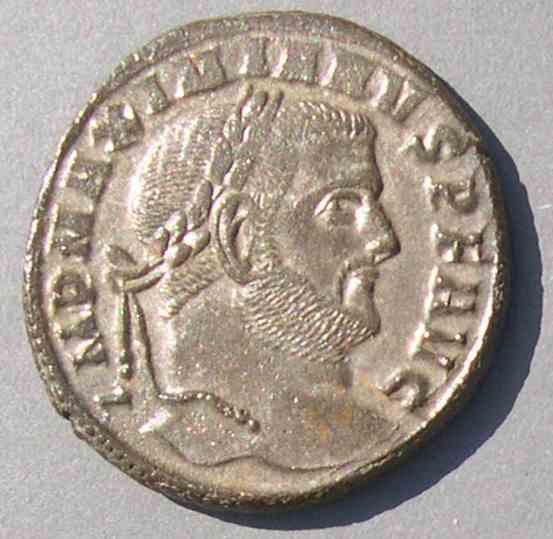
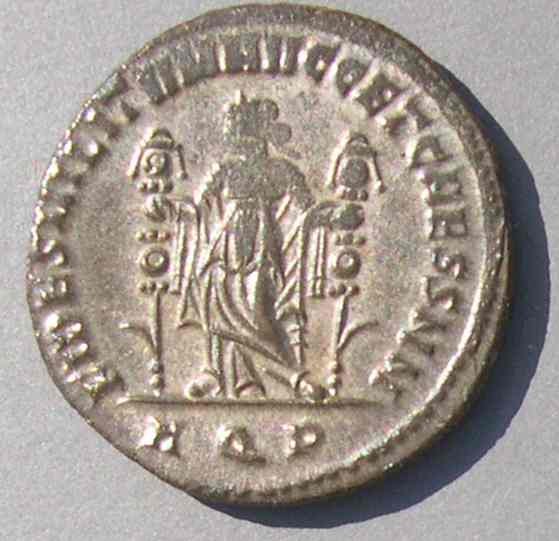
Coin 1
Galerius , as Augustus
27 mm.
Struck c. 305 at Aquileia.
IMP MAXIMIANVS PF AVG
FIDES MILTITVM AVGG ET CAESS NN
(Comments for collectors about the values of these coins.)
| Second Tetrarchy | West | East |
| Augustus | Constantius | Galerius [1] |
| Caesar | Severus II | Maximinus II |
| Retired Augusti | Diocletian [1A] | Maximian [1B] |
Relatives, soon to be rulers: Maxentius, son of Maximian and Constantine, son of Constantius
Regions of the Second Tetrarchy:
Constantius: Gaul, Spain, and Britain (primary mint, Trier)
Severus: The former territory of Herculius: Italy, Africa, Pannonia (including Siscia)
Galerius: Asia Minor, Greece, eastern Illyricum
Maximinus: Syria and Egypt
The mints of 306-310 are given below in an appendix. During the second tetrarchy mints all across the empire continued to strike coins for all four active rulers, as well as for Diocletian and Maximian as retired, "senior," emperors.5
The Augustus we call Galerius was named Galerius Maximianus. His coins which used legends such as IMP MAXIMIANVS PF AVG [1] can easily be confused with coins of Maximianus Herculius . Since Herculius was never titled Caesar on coins and Galerius was, when coins of "MAXIMIANVS" use the title NOB C instead of AVG, they belong to Galerius. Galerius's coins as Augustus can be distinguished by type, size, and sometimes by the legend containing GAL VAL preceding MAXIMIANVS [Coin 2]. However, one must be careful to note that only the extra "A" distinguishes (GAL VAL) MAXIMIANVS (Galerius) from (GAL VAL) MAXIMINVS (Maximinus [Coin 3]), both as Caesar and as Augustus.
Again the two new rulers were not natural sons of the Augusti, but were adopted into the dynasties. This is remarkable, especially considering Maximian Herculius had an eligible son, Maxentius, and Constantius had an eligible son, Constantine. Even the philosopher emperor Marcus Aurelius had chosen his son, Commodus, to succeed him rather than continue the adoptive system that had resulted in "the good emperors" of the second century. However, reversion to a dynasty based on blood relationship was presaged with the appointment of Maximinus, who was a nephew of Galerius and not an experienced soldier.
The upcoming events occur largely in the west, leaving the eastern situation basically unchanged. That is, Galerius remained eastern Augustus and Maximinus remained second in command in the east until mid 310. Nevertheless, coins minted in the East reflect the turmoil in the West as new rulers and titles were or were not accepted in the East as legitimate.
In July 306, when Constantius was terminally ill on campaign at York, England, he exercised his right as Augustus to award his own son, Constantine, imperium, that is, imperial power. The western army of Constantius acclaimed Constantine. Galerius was left out of the selection process. When Constantius died July 25, the Caesar Severus was promoted to Augustus of the West as expected [Coin 4], and there was nothing for Galerius to do but accept the popular son of Constantius, Constantine, as the new western Caesar [Coin 5]. Constantine took over Constantius's portion of the empire and began minting coins as Caesar, with Trier his primary mint 6 [Coin 6].
The Third Tetrarchy (July 25, 306 - c. April, 307).
| West | East | |
| Augustus | Severus II [4] | Galerius [2] |
| Caesar | Constantine [5, 6] | Maximinus II [3] |
During this short period, mints of each of the four legitimate rulers struck for the other legitimate rulers and the two retired emperors.
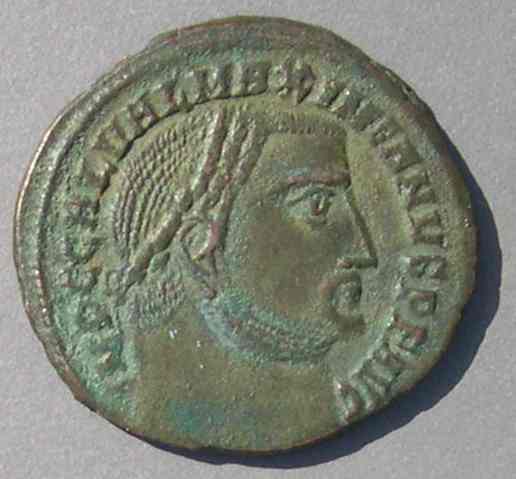
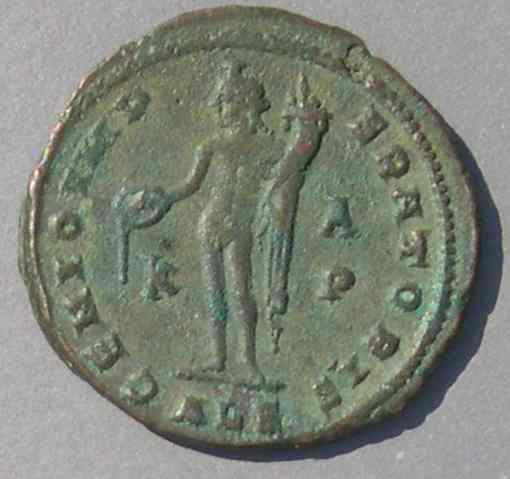
Coin 2
Galerius, as Augustus
25 mm.
Struck late 308 - 310
at Alexandria
IMP C GAL VAL MAXIMIANVS PF AVG
[not MAXIMINVS, compare to the next coin.]
GENIO IMPERATORIS

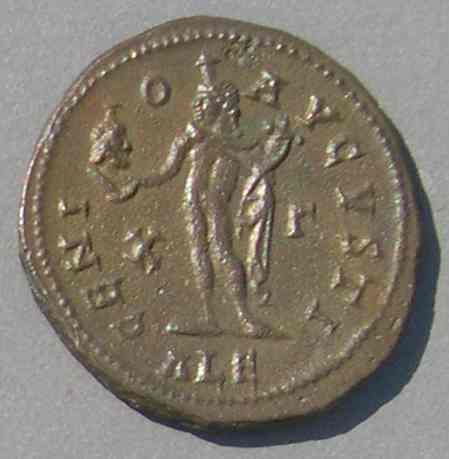
Maximinus II
23 mm. 12:00.
Struck 312 as Augustus at his own mint Alexandria
IMP C GAL VAL MAXIMINVS PF AVG
[not MAXIMIANVS, compare to the previous coin.]
GENIO AVGVSTI
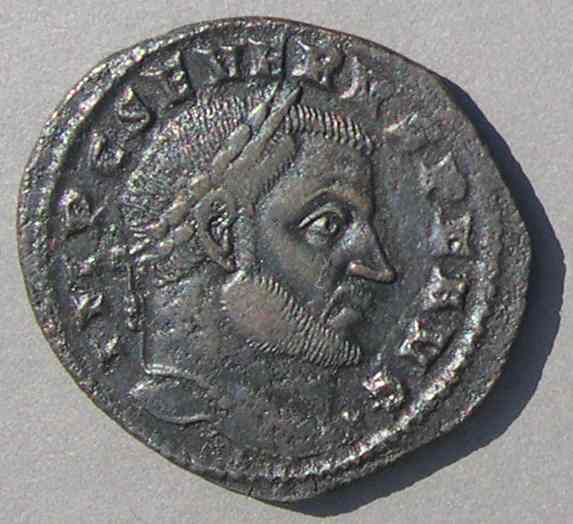

Coin 4
Severus II
28-25 mm. 12:00.
Struck December 306
at Ticinum, his own mint.
IMP SEVERVS PF AVG
FIDES MILITVM
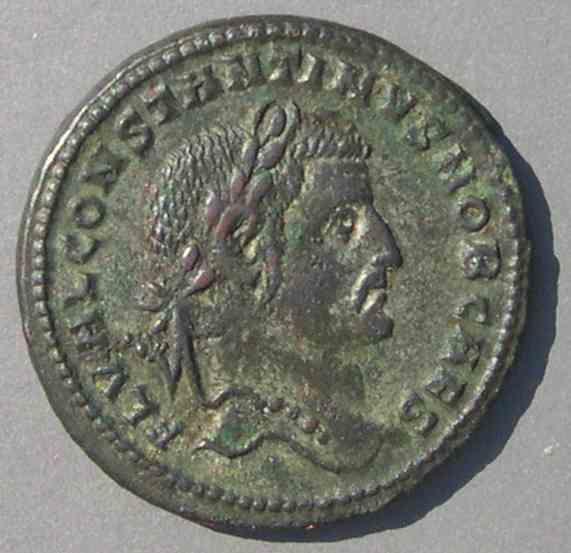

Constantine as Caesar
27 mm. 10.60 grams. 6:00.
Struck 306 at Cyzicus, a mint of Galerius.
FL VAL CONSTANTINVS NOB CAES
GENIO AVG ET CAESARVM NN
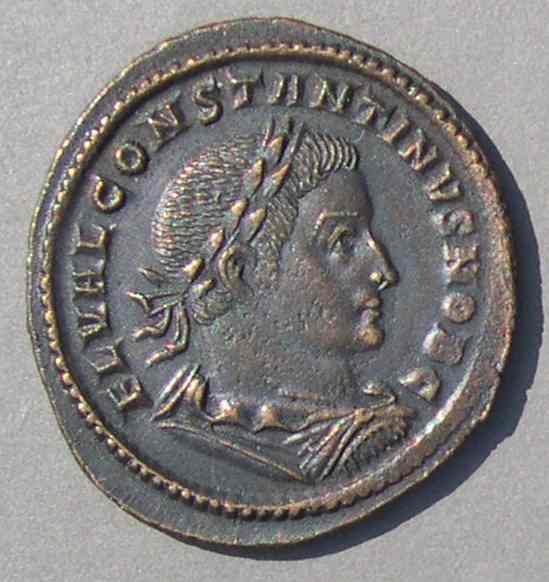
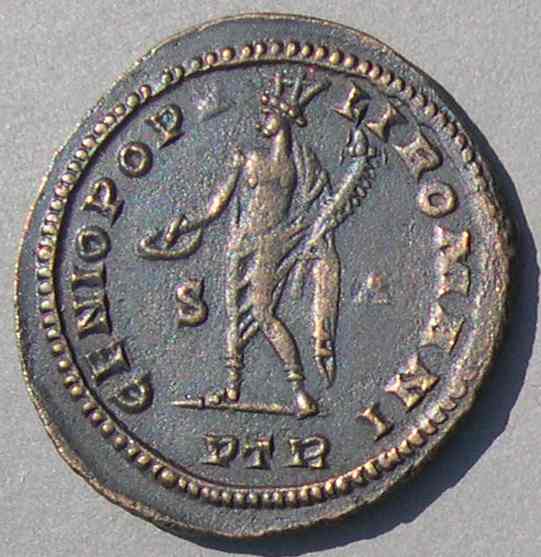
Coin 6
Constantine as Caesar
29-28 mm. 5:30.
Struck c. Spring 307 at Trier, his own mint.
FL VAL CONSTANTINVS NOB C
GENIO POPVLI ROMANI
From 293 to 306 was apparently long enough to accustom people to this new system with two Augusti and two Caesars. Every member was according respect to every other member. But we can imagine Maximinus II must have been irritated to see Severus attain the status of Augustus after only 1 year. Also, quite a few people must have been concerned that Constantine had been able to advance without the consent of the other rulers by the old tried-and-true military method, making an end run around the system. If he could, why couldn't they?
Maxentius did. Son of the retired Herculian Augustus Maximian, he usurped power at Rome in Severus' territory on October 28, 306, while Severus was in the north. Most soldiers near the traditional center of the empire had served under Maximian Herculius and looked favorably on his son's coup. Maxentius knew he had formidable opponents and enlisted the aid of his father Maximian, who more-than-willingly left retirement and assumed his former position of Augustus. Who was to stop them?
Rare coins show the hesitant nature of Maxentius' entry in the sweepstakes. He began with the un-tetrarchic inferior title "Princips" and then "Caesar" (at Carthage only) while recognizing his father as active (as opposed to retired) Augustus [Coin 7]. He apparently took the supreme title Augustus c. summer 307 [Coin 8], well after the revolt, but before he struck many coins in his own name.
The revolt necessarily provoked an immediate reaction from the legitimate members of the system, especially Galerius and Severus. Maxentius tried to stay on the good side of Constantine by minting for him [Coin 9], but Constantine did not return the favor.7
Mints striking for various rulers, Late 306 - Summer 307
(i.e. Revolt of Maxentius - death of Severus)
For Maxentius: Only his own mints. Only very rare coins as Princips until c. summer 307 and coins as Caesar only at Carthage
(which probably expected Maximian Herculius to be the sole western Augustus).
Coins as Augustus commence after summer 307 [8].
For Maximian Herculius, as active, senior, Augustus: Mints of Maxentius [7]. As senior Augustus at Constantine's mints [10]. As retired Augustus with Diocletian, at Constantine's mints and throughout the East.
For Constantine as Caesar: Mints of Constantine [6], Maxentius, Severus, Galerius [5], and Maximinus [11]. That is, mints of all "legitimate" rulers and also mints of the usurper Maxentius.
For Severus and Galerius: Mints of Severus [4], Galerius, Maximinus, and Constantine, but not mints of Maxentius.
For Maximinus II: Mints of Severus, Galerius, Maximinus, and Constantine [12], and Carthage, a mint of Maxentius.
In summary, the four recognized members of the third tetrarchy struck for each other, but not for Maxentius. Maxentius struck for himself, for his father as Augustus, for Constantine and Maximinus as Caesars, but not for the other two members of the tetrarchy.


Coin 7
Maximian, as active Augustus
29-27 mm. 12:00.
Struck late 306 - early 307
at Carthage, a mint of Maxentius, his son.
IMP MAXIMIANVS SEN AVG
CONSERVATOR AFRICAE SVAE >
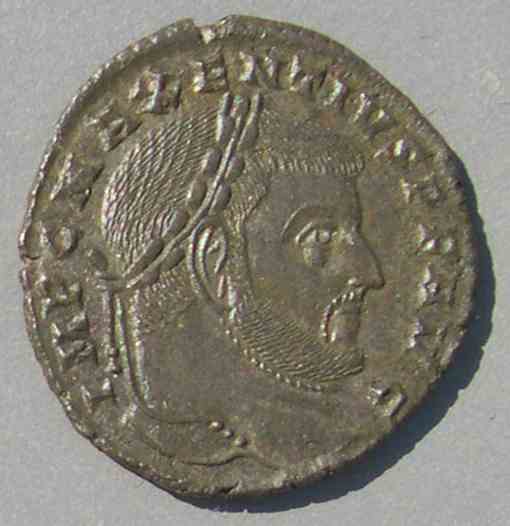
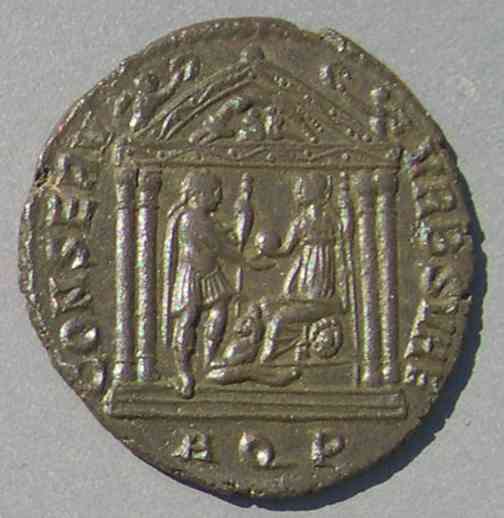
Coin 8
Maxentius
26-25 mm. 6.55 grams. 12:00.
Struck as Augustus, late summer 307
at Aquileia, his own mint.
IMP C MAXENTIVS PF AVG
CONSERV VRB SVAE
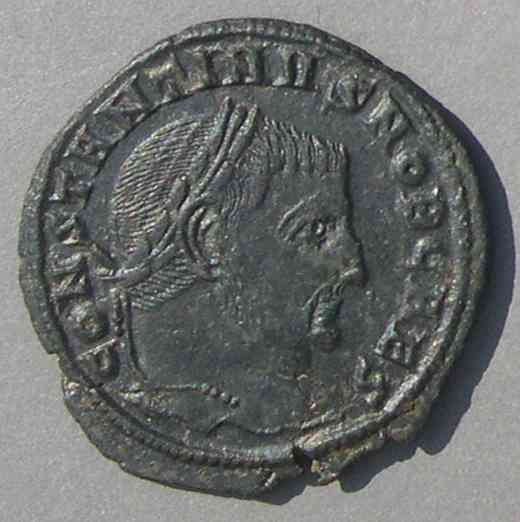
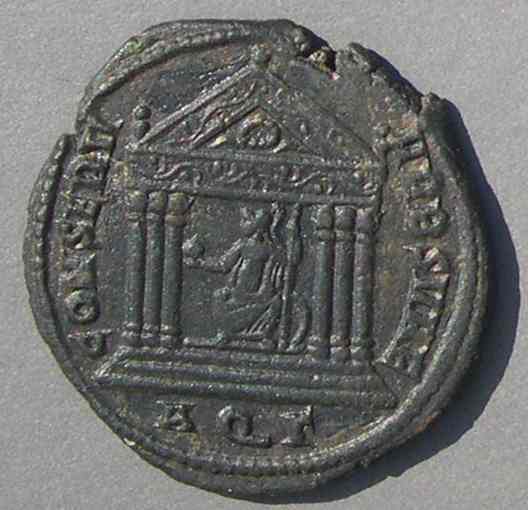
Coin 9
Constantine, as Caesar
26 mm. 6:00.
Struck late summer, 307 at Aquileia, a mint of Maxentius.
CONSTANTINVS NOB CAES
CONSERV VRB SVAE

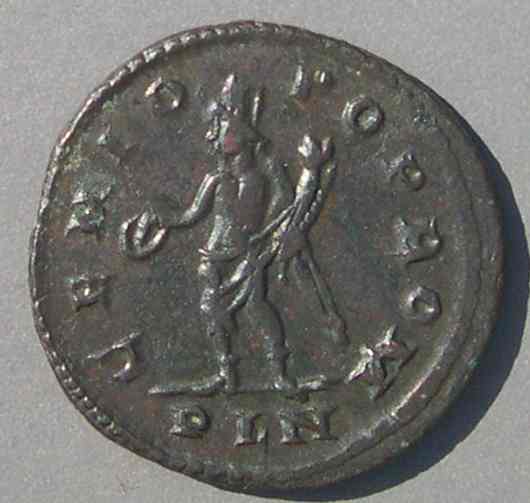
Maximian as Senior Augustus.
25-24 mm.
at London, a mint of Constantine.
Struck summer 307.
DN MAXIMIANO S AVG
"S" for Senior.
GENIO POP ROM
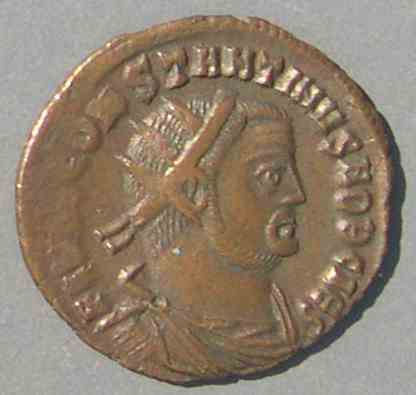
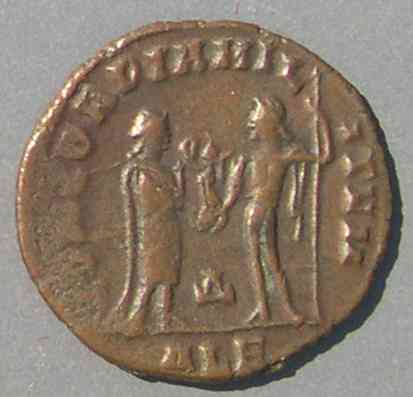
Coin 11
Constantine, as Caesar
20 mm.
Struck Autumn 306 - early 307 at Alexandria,
a mint of Maximinus II.
FL VAL CONSTANTINVS NOB CAES
CONCORDIA MILITVM
Coin 12
Maximinus II, as Caesar
27 mm.
Struck 1 May 305 - early 307
at Trier, a mint of Constantine
GAL VAL MAXIMINVS NOB C
GENIO POPVLI ROMANI
Galerius ordered Severus to recover Rome. After all, Severus was supposed to be Augustus of the West, although his capital was Milan and his mints were Ticinum [Coin 4], Aquileia, and Siscia. Severus' advance toward and subsequent siege of Rome in Spring 307 failed dismally because his soldiers, many of whom had served under Maximian, melted away as they succumbed to bribes or were simply unwilling to fight. At the approach of an army under Maximian, Severus retreated to Ravenna where he was forced to surrender. At first held as a hostage against Galerius, he was soon put to death.
As Severus' failure became apparent, Galerius decided to try to recover Rome himself. Anticipating the attack, Maximian fortified Rome and then went to enlist Constantine's aid. He used his authority as an active Augustus to confirm Constantine in power and cemented the relationship by giving the hand of his daughter, Fausta, to Constantine in marriage. Galerius' attack failed for the same reasons as Severus', and he retreated to Illyricum, perhaps even before the return of Maximian to Rome. So Maxentius controlled Carthage, Rome, Ticinum, and Aquileia, but not Siscia.
All this happened by summer of 307. With the western Augustus Severus dead and the position vacant, it is not surprising that Constantine took the title of Augustus (July 25, 307)8 [Coin 13]. Nor is it surprising that Maxentius did, too [Coin 8].
| West | East | |
| Augustus | Maxentius, Maximian [14,15], Constantine [13] | Galerius |
| Caesar | none | Maximinus II |
Rulers did not necessarily recognize each other's titles, unlike under the tetrarchic system.
Mints striking for various rulers, Late Summer 307 - Late 308
For Constantine: Constantine's mints [13], and Maxentius' mints until the break in Spring 308 [9].
For Maxentius: Only his own mints [8].9
For Maximian Herculius as an active ruler: Constantine's mints [15], and Maxentius' mints until the break in Spring 308 [14].
As retired with Diocletian: Eastern mints [16].
For Galerius and for Maximinus II: Mints of Galerius and Maximinus.1
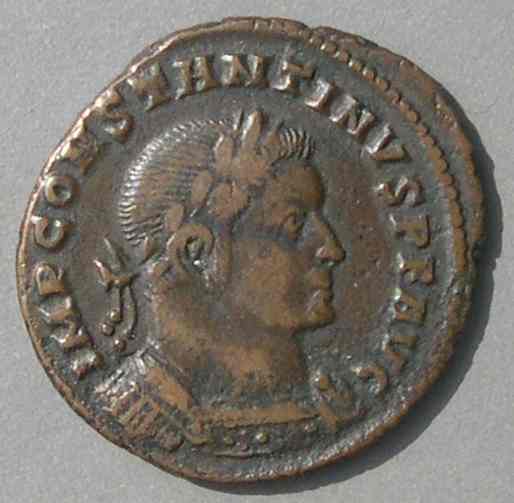

Coin 13
Constantine
Struck autumn 307-end of 308 at Trier
IMP CONSTANTINVS PF AVG
MARTI PATRI CONSERVATORI

Coin 14
Maximian, as active Augustus
25 mm.
Struck Autumn 307 - c.309/310
at Aquileia.
IMP C MAXIMIANVS PF AVG
CONSERV VRB SVAE


Maximian, as active Augustus
27 mm.
Struck Autumn 307 - end of 308
at Trier, a mint of Constantine.
IMP C VAL MAXIMIANVS PF AVG
GENIO POP ROM
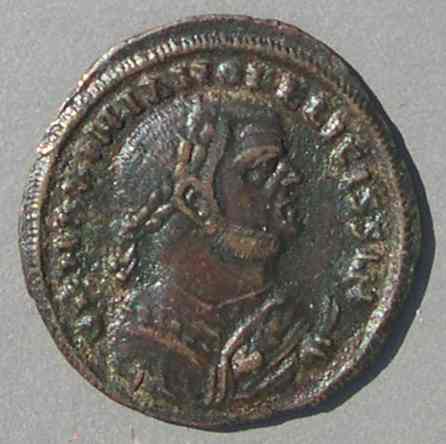
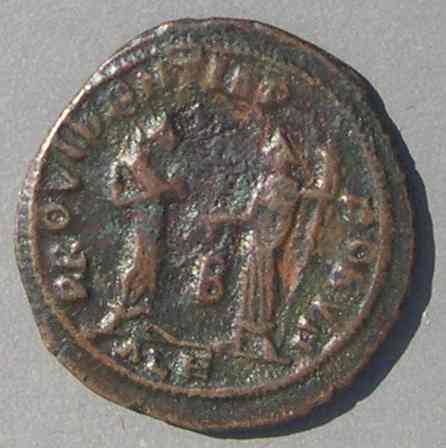
Coin 16
Maximian, who retired in 305 AD.
22 mm. 3.06 grams. 12:00.
Struck early to mid 308 at Alexandria.
DN MAXIMIANO FELICISSIM
PROVIDENTIA DEORVM
Maxentius' claim to fame was only that he was the son of Maximian, but Maxentius kept power for himself. Maximian tried, but was unable to convince the army to follow him instead of his son. This broke their alliance and Maximian sought refuge with Constantine (Spring 308). This relocation was mutually beneficial. Maximian joined someone with military power who was willing to accord him the status of active Augustus. Constantine gained the support of a well-known elder statesman.
The respectful recognition on coins of co-rulers that had been a remarkable aspect of the tetrarchic system gave way to recognition based solely on power politics. Maxentius was a usurper and his omission from the coins of the mints of Constantine and the eastern rulers is only to be expected. However, Maxentius minted for Constantine until the break with his father in Spring 308. Constantine did not mint for Maxentius or the eastern rulers.
The death of Severus and Constantine's promotion to Augustus without eastern approval left the East unwilling to recognize anyone in the West. When Severus' death caused his disappearance from issues at eastern mints, Constantine disappeared too.11
The western rulers Maxentius, Maximian, and Constantine, all claiming to be Augustus, clearly had rejected the method of orderly succession formerly associated with the tetrarchic system. Nevertheless, each probably would have been pleased to have no rivals and be the only western Augustus, recognized by the East in a restored system.
Carnuntum. Galerius, the senior emperor, wanted to restore the old order. He persuaded the retired Diocletian to lend his authority to a reconciliation conference to be held at Carnuntum (on the Danube, just east of Vienna) in late 308.12 Maximian also came. The results were (1) Maximian was forced to retire again, (2) a new man, Licinius, was promoted to Augustus of the West without ever having been Caesar, (3) Constantine was demoted back to Caesar, and (4) Maxentius was declared a public enemy. That these decisions did not please everybody is obvious.
The Carnuntum Decisions, Late 308.
| West | East | |
| Augustus | Licinius | Galerius |
| Caesar | Constantine | Maximinus II |
Maximian--retired, for the second time
Maxentius--"public enemy"
Maximian Herculius lost all rank and became a "private citizen." Because he had no army, he could only go back to live under the wing of Constantine. Of course, Constantine refused his demotion, and Maximinus protested the elevation of Licinius. Galerius tried to strike a compromise by inventing and awarding the title "Filius Augusti" to these two. Regardless of whether it was supposed to be a rank higher than Caesar, Maximinus would not have it and continued to strike coins for himself with his old title Caesar [Coin 17]. Constantine continued to strike with the title Augustus. Coins show each as FIL AVG or FIL AVGG, but only at mints they did not influence. Galerius, who thought up the idea, struck FIL AVGG coins (with two G's) for both Constantine and Maximinus II at Siscia and Thessalonica [Coins 18-22]. In addition, FIL AVG coins (with one G) were struck by Galerius for Constantine at Nicomedia and by Maximinus for Constantine at Antioch and Alexandria [Coins 23-25].13 Maximinus did not strike them for himself [Coin 17]. Other eastern mints simply did not strike for Constantine at all. Constantine did not strike for Galerius ever again, or for Maximinus until he became Augustus with Constantine in mid 310.
FIL AVG(G) types of Constantine and Maximinus II (late 308 - mid 310)
| Ruler | Reverse Legend | Mint | RIC# |
| Constantine | GENIO AVGVSTI [21] | Siscia | 200b |
| " | GENIO CAESARIS | Siscia | 203 |
| " | GENIO CAESARIS [22] | Thessalonica | 32b |
| " | GENIO CAESARIS | Antioch | 104 |
| " | GENIO CAESARIS [25] | Alexandria | 99b, 100b |
| " | GENIO CAESARIS CMH 14 [23] | Nicomedia | 56 |
| " | GENIO FIL AVGG [24] | Antioch | 105, 111 |
| " | VIRTVTI EXERCITVS [20] | Thessalonica | 39b |
| " | VIRTVTI EXERCITVS CMH | Nicomedia | 61 |
| " | VIRTVS EXERCITVS | Alexandria | 113, 117 |
| Maximinus II | GENIO AVGVSTI [18] | Siscia | 200a |
| " | GENIO CAESARIS [19] | Thessalonica | 32a |
| " | VIRTVTI EXERCITVS [20] | Thessalonica | 39a |
Notes : The three GENIO legends are all associated with the same design: Genius standing left holding patera and cornucopia. This is the same design as on the common GENIO POPVLI ROMANI type. The VIRTVS EXERCITVS type shows a helmeted Virtus advancing right in military dress, holding transverse spear in his right hand and a trophy over his shoulder with his left. It was new with the first issue of Licinius [Coin 26].
At Siscia and Thessalonica, obverses have FIL AVGG with two Gs.
At Nicomedia, Antioch, and Alexandria, obverses have FIL AVG with only one G.
For Constantine, the difference between Alexandria 99b and 100b is extremely minor, divergent or parallel wreath ties, which is also the difference between Alexandria 113b and 117b.
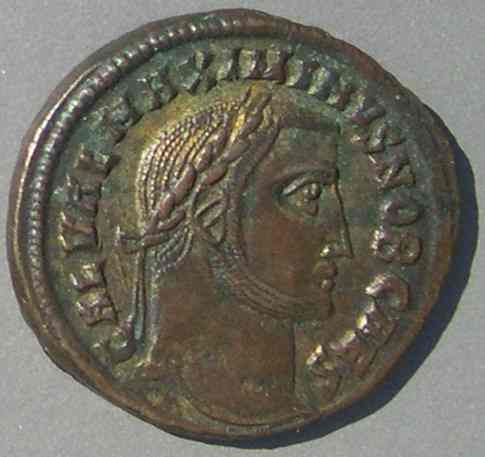
 Coin 17
Coin 17
Maximinus II, as Caesar
25 mm.
Struck late 308 - 310
at Alexandria, his own mint,
without the FIL AVG title.
GAL VAL MAXIMINUS NOB CAES
GENIO CAESARIS

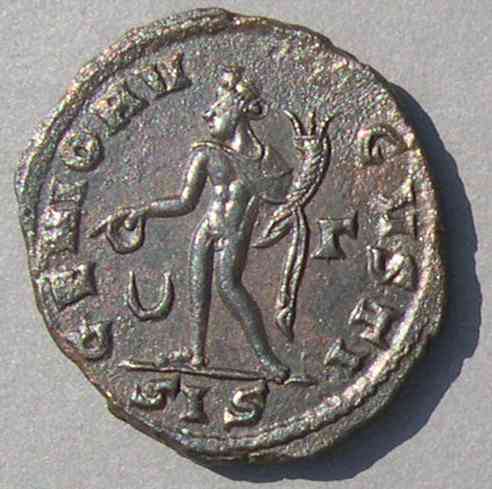
Coin 18
Maximinus II, as FIL AVGG
25-23 mm.
Struck c.309 - May 310
at Siscia, a mint of Galerius
MAXIMINVS FIL AVGG
GENIO AVGVSTI

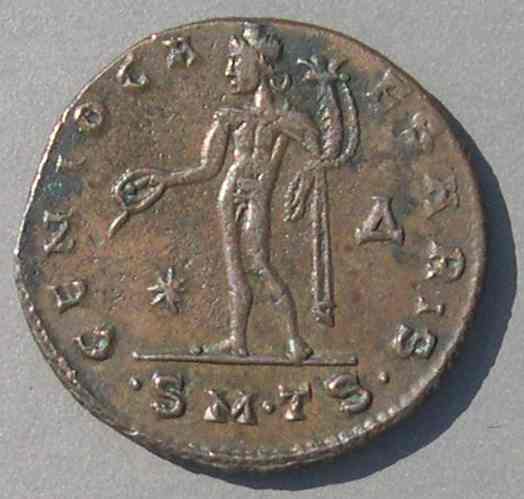
Coin 19
Maximinus II, as FIL AVGG
25 mm.
Struck late 308 - May 310
at Thessalonia, a mint of Galerius.
MAXIMINVS FIL AVGG
GENIO CAESARIS

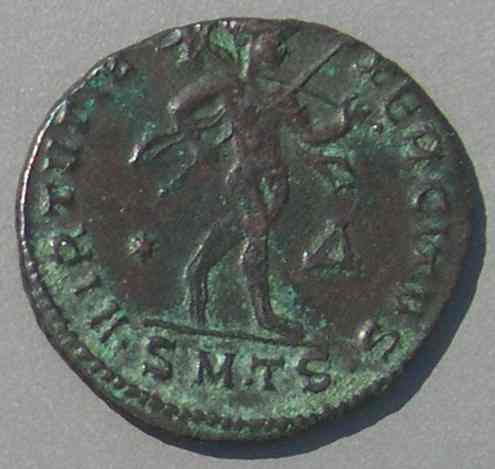
Coin 20
Maximinus II, as FIL AVGG
25-23 mm.
Struck late 308 - May 310
at Thessalonica, a mint of Galerius
MAXIMINVS FIL AVGG
VIRTVTI EXERCITVS
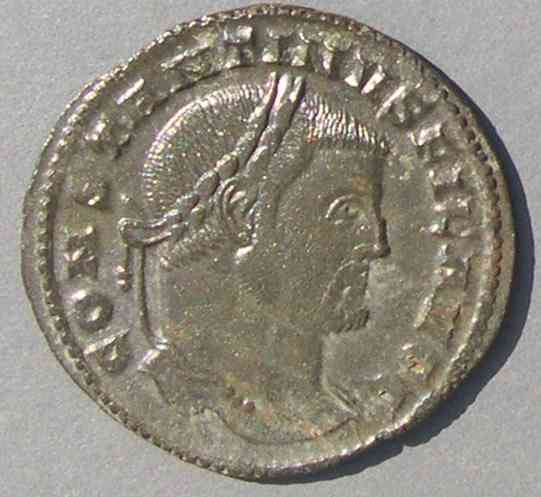
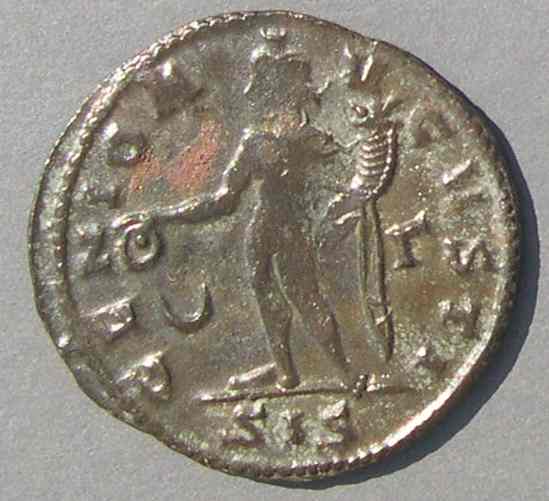
Coin 21
Constantine, as FIL AVGG
27-26 mm. 5.08 grams.
Struck late 308 - May 310
at Siscia, a mint of Galerius
CONSTANTINVS FIL AVGG
GENIO AVGVSTI
RIC Siscia 200b
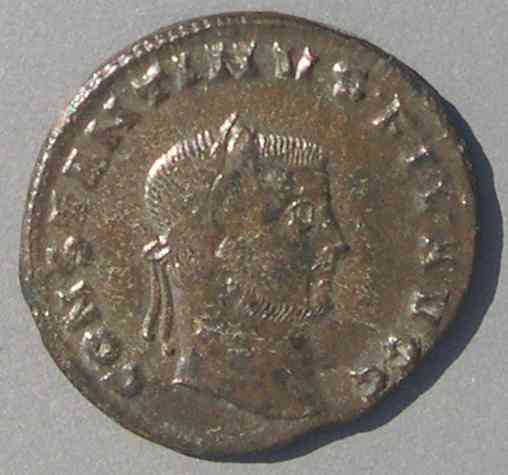
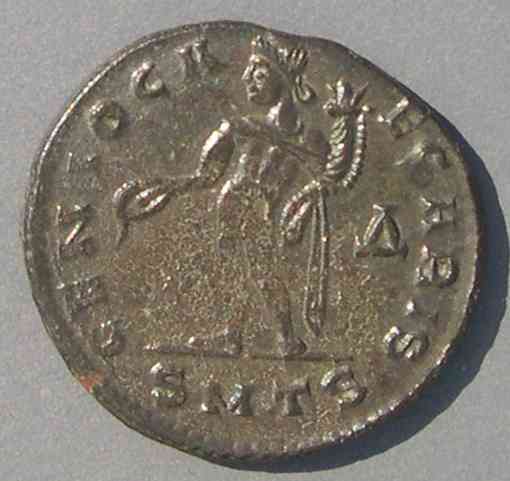
Coin 22
Constantine, as FIL AVGG
25-23 mm. 6.41 grams.
Struck late 308 - May 310
at Thessalonica, a mint of Galerius
CONSTANTINVS FIL AVGG
GENIO CAESARIS
RIC Thessalonica 31b
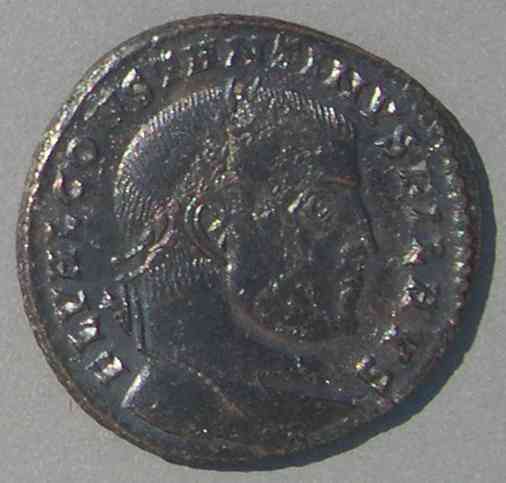
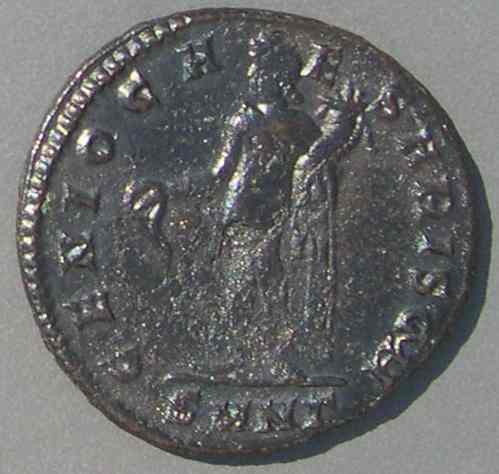 Coin 23
Coin 23Constantine, as FIL AVG
25 mm.
Struck late 308 - May 310
at Nicomedia, a mint of Galerius
CONSTANTINVS FIL AVS [sic]
[only one G, written as S]
GENIO CAESARIS CMH [elided]
RIC Nicomedia 56
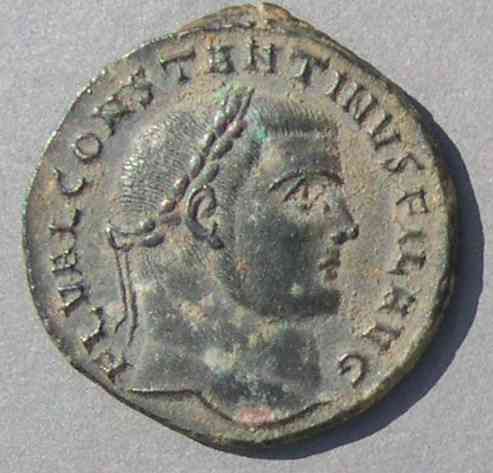
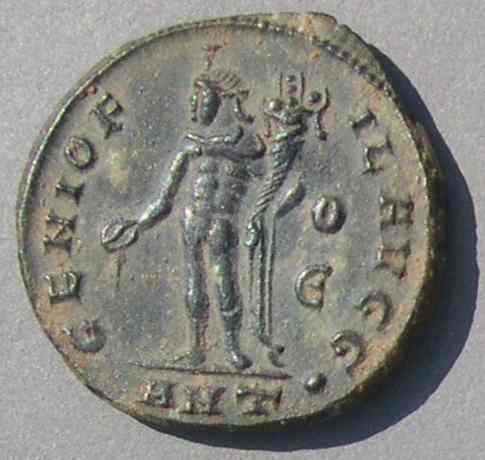 Coin 24
Coin 24
Constantine, as FIL AVG
24 mm.
Struck c. early to later 309
at Antioch
FL VAL CONSTANTINVS FIL AVG
[only one G]
GENIO FIL AVGG
(This is the only mint which mentions FIL AVGG on the reverse.)
RIC Antioch 111


Coin 25
Constantine, as FIL AVG
25 mm.
Struck late 308 - May 310
at Alexandria
FL VAL CONSTANTINVS FIL AVG
[only one G]
RIC Alexandria 100b

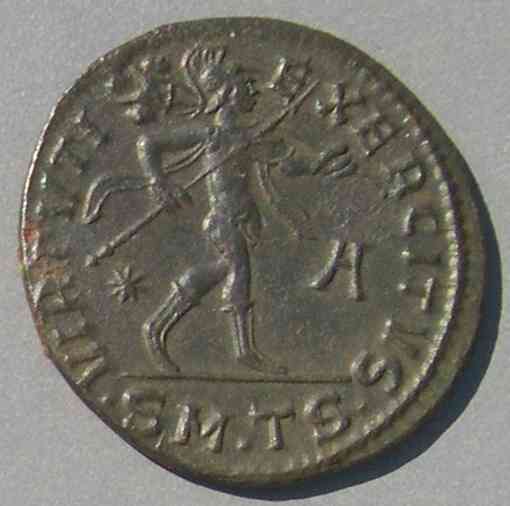
Coin 26
Licinius, as Augustus
(he was never Caesar, but his son was)
26 mm.
Struck late 308 - May 310
at Thessalonica (alongside the FIL AVGG pieces)
VAL LICINIVS PF AVG
VIRTVTI EXERCITVS
Galerius was responsible for the Balkans and Asia Minor. Licinius held only the former territory of Severus, minus that held by Maxentius. After the end of our time period the deaths of the eastern rulers left Licinius to inherit the East. Because most of his coins are later issues that mention IOVI CONSERVATORI, collectors are likely to think of Licinius as a Jovian, eastern, emperor [Coin 27]. Nevertheless, technically he began as the western emperor, with Pannonia (including Siscia) as his territory.
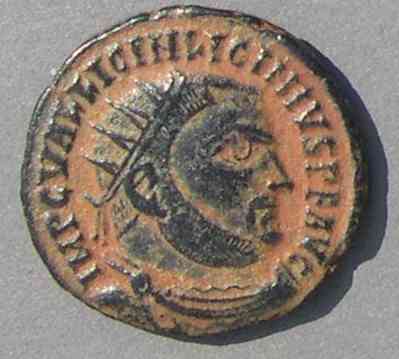
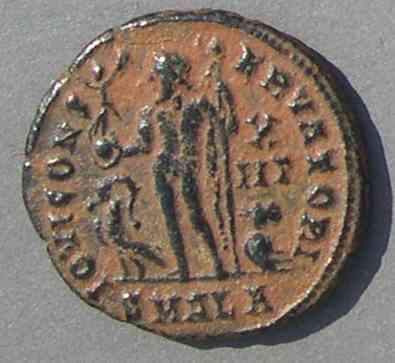 Coin 27
Coin 27 Licinius, as Augustus
19 mm.
Struck 321-324
at Alexandria
IMP C VAL LICIN LICINIVS PF AVG
IOVI CONSERVATORI
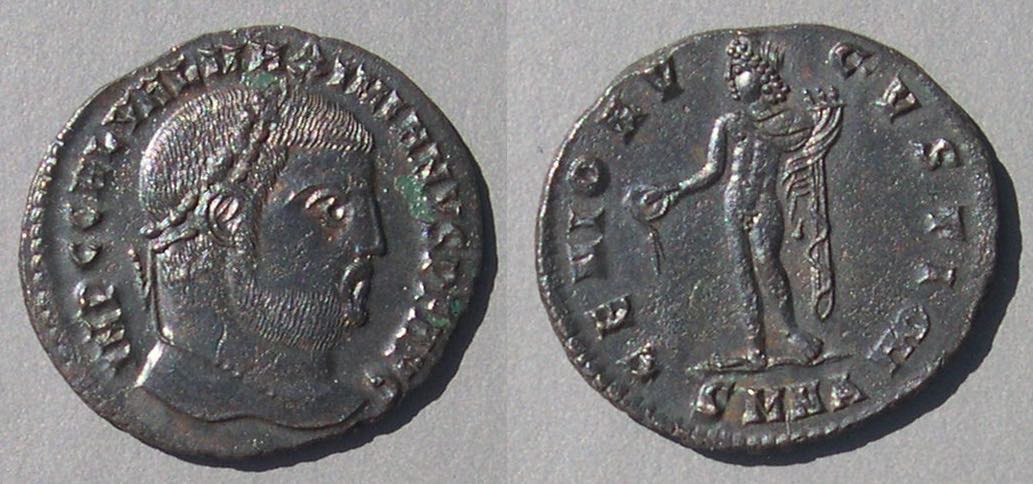
Coin 28
Galerius, as Augustus
26-24 mm.
Struck 308-310
at Nicomedia
IMP C GAL VAL MAXIMIANVS PF AVG
GENIO AVGVSTI CMH [elided]
Mints striking for various rulers, late 308 - mid 310, i.e. after the Conference at Carnuntum.
For Galerius: Only mints of Galerius [28] and Maximinus.
For Maximinus II: His own mints, as Caesar [17]. Mints of Galerius as FIL AVGG [18-20] and Caesar [29].
For Constantine: Constantine's mints, as Augustus. Maxentius' mints, as Augustus, until the break in Spring 308. Five eastern mints as FIL AVGG or FIL AVG [21-25].
For Licinius: All mints except those of Maxentius. (Constantine [30]15, Maximinus [27], Galerius [26, 31].)
For Maxentius: Only his own mints.
For Maximian Herculius: Maximian does not really have second retirement types, but he does have types struck during his second retirement. This requires clarification.
In the West, retirement types disappear (even for Diocletian) shortly after Maximian resumed power for the second time. Neither receives western retirement issues again. Maximian's revolt left no mark on the coins; he has no western issues at all after Carnuntum.
In the East, only Antioch [Coin 34] and Alexandria coined for him after Carnuntum, and their coins style him as senior but active Augustus, as opposed to Diocletian's coins which style him as senior but retired. So, at Maximinus II's mints, after Maximian's second retirement in the West, types were struck for Maximian suggesting an active reign. This recognition was probably because Maximian was hostile to Galerius and Licinius, as was Maximinus II. The smaller eastern retirement types of Maximianus [16] were struck before Carnuntum, when Maximian had retired only once.16
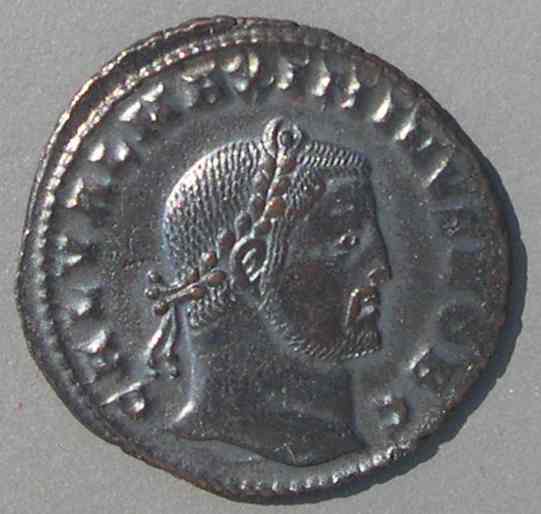
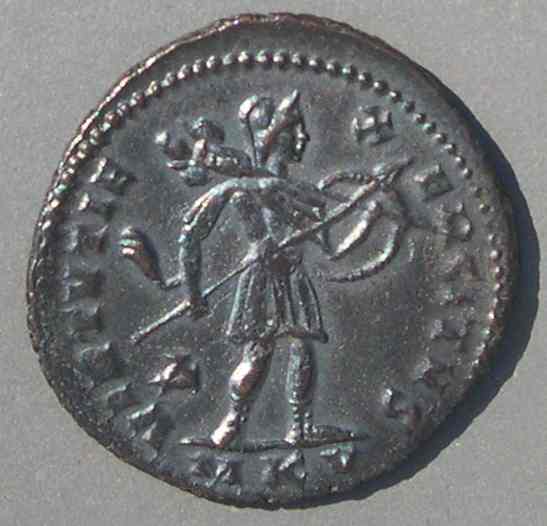
Coin 29
Maximinus II, as Caesar
26 mm.
Struck late 308 - 309
at Cyzicus
GAL VAL MAXIMINVS NOB C
VIRTVTI EXERCITVS
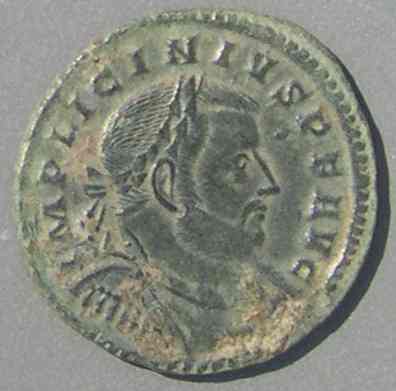
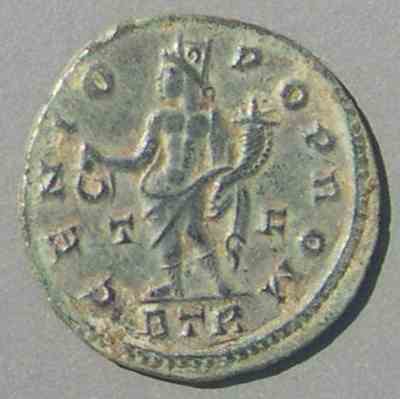 Coin 30
Coin 30
Licinius, as Augustus
20 mm.
Struck late 308 - 309
at Trier, a mint of Constantine
IMP LICINIVS PF AVG
GENIO POP ROM
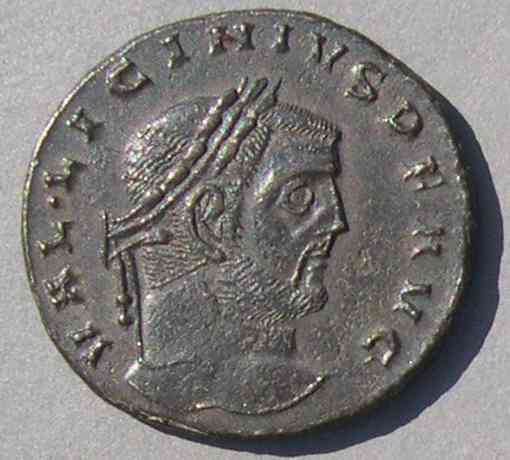
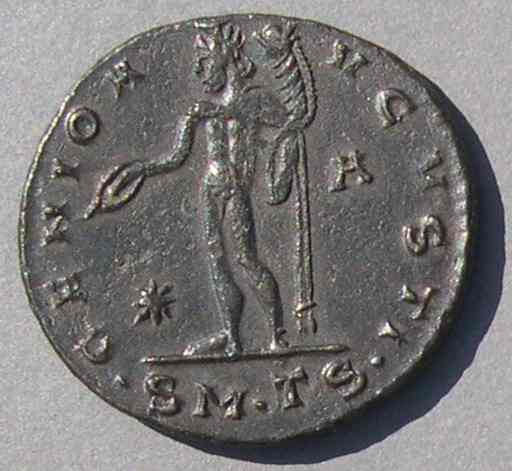
Coin 31
Licinius, as Augustus
25-24 mm.
Struck late 308 - May 311
at Thessalonica
VAL LICINIVS PF AVG
GENIO AVGVSTI

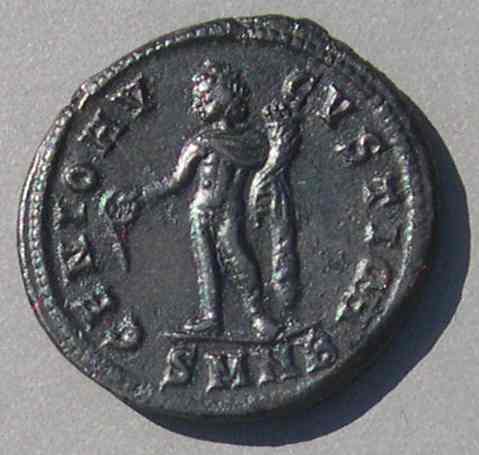
Coin 32
Maximinus II, as Augustus
22 mm.
Struck 310-311
at Nicomedia
IMP C GAL VAL MAXIMINVS PF AVG
GENIO AVGVSTI CMH [elided]
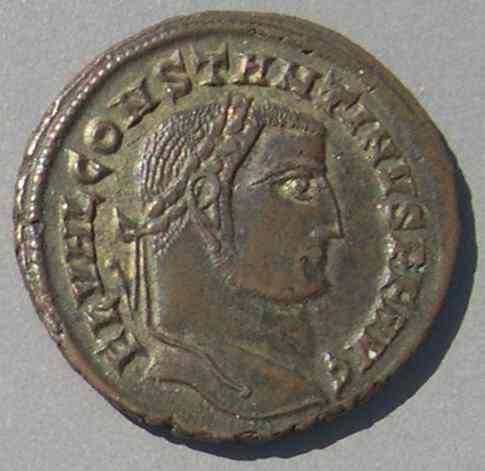
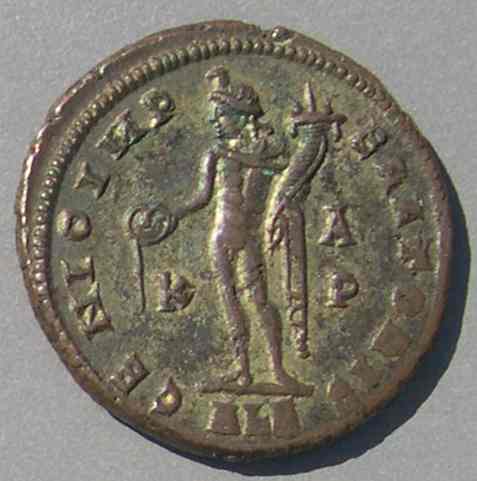 Coin 33
Coin 33
Constantine, as Augustus
24 mm.
Struck mid 310
at Alexandria,
with the same controlmarks at the FIL AVGG issue [25][17]
FL VAL CONSTANTINVS PF AVG
GENIO IMPERATORIS
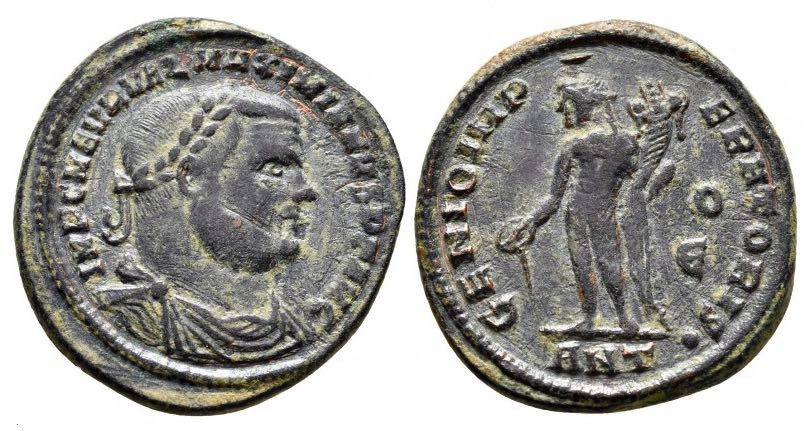 Coin 34
Coin 34Maximian, after the Conference at Carnuntum.
Third reign, Dec. 308 - Spring 310,
25-24 mm. 7.21 grams.
Struck "early to later 309"
at Antioch
GENIO IMPERATORIS
O
Є
ANT
RIC VI Antioch 112c.
We know this was after Carnuntum because the issue is shared with Licinius.
Maximian did not accept the demotion decided at Carnuntum. In mid 309 an abortive attempt of Maximian to take power from Constantine resulted in Maximian's rapid defeat, his third retirement, and then his execution for still further plotting in 310. No coins of the revolt of Maximian were issued in the west, but Antioch and Alexandria had rare joint "third reign" issues with Licinius (Coin 34).
Meanwhile, the East was still minting FIL AVG coins. That episode came to an end when Maximinus II, dissatisfied with his long tenure as Caesar, had his troops proclaim him Augustus in mid 310 [Coin 32, Coin 3].17 This may have coincided with the beginning of Galerius's long terminal illness, which may explain why Galerius simply gave in to the pressure and confirmed both Maximinus and Constantine as Augusti. The FIL AVG issues were replaced by similar types with AVG [Coin 33].
The date is no major milestone. The pace of events continued unabated. Much remained to be sorted out before the list of five Augusti (Galerius, Maximinus, Constantine, Licinius, and Maxentius) was pruned down to one by Constantine. But that's another long story, and in it there is no Filius Augusti. 18
Comments and corrections are solicited. Write me at: 
Appendix: Mints during 306-310
(listed more or less west to east)
London, Treveri (Trier), Lugdunum (Lyons), Rome, Ostia, Carthage, Ticinum, Aquileia, Siscia, Serdica, Thessalonica, Heraclea, Nicomedia, Cyzicus, Antioch, Alexandria.
Notes : The dividing line between West and East was usually between Aquileia and Siscia, or between Siscia and Serdica.
London, Trier, and Lugdunum were an inheritance from Constantius and belonged to Constantine throughout this period.
Antioch and Alexandria belonged to Maximinus II throughout this period.
Ostia was opened by Maxentius in 308/309.
Siscia closed with Severus' defeat and resumed minting when Licinius became Augustus.
Serdica opened in 303 and closed in 308 before Licinius became Augustus.
Thessalonica, closed since 303, reopened as Galerius' principal Balkan mint when Licinius became Augustus [26, 31].
In this period the mintmark prefix SM (Sacra Moneta) probably denotes principal mints that were striking gold.
Roman Imperial Coinage reference numbers.
1. Galerius FIDES MILITVM AVG ET CAESS NN. Aquileia 60b.
1A. Diocletian abdication Trier 677a
1B. Maximian adbication Trier 676b
2. Galerius GENIO IMPERATORIS. [3] Alexandria 101a.
3. Maximinus GENIO AVGVSTI. [2] Alexandria 149b.
4. Severus FIDES MILITVM. Ticinum 73.
5. Constantine GENIO AVGG ET CAESARVM NN. Cyzicus 24b.
6. Constantine GENIO POPVLI ROMANI [15]. Trier 694.
7. Maximian CONSERVATOR AFRICAE SVAE. Carthage 56.
8. Maxentius CONSERV VRBS SVAE [9, 14]. Aquileia 113.
9. Constantine CONSERV VRBS SVAE. [8, 14] Aquileia 117.
10. Maximian GENIO POP ROM [15]. London 90.
11. Constantine CONCORDIA MILITVM. Alexandria 85.
12. Maximinus GENIO POPVLI ROMANI [6]. Trier 667b.
13. Constantine MARTI PATRI CONSERVATORI. Trier 772a.
14. Maximian CONSERV VRBS SVAE [8, 9]. Aquileia 121b.
15. Maximian GENIO POP ROM [6, 10, 12]. Trier 768.
16. Maximianus PROVIDENTIA DEORVM. Alexandria 87b.
17. Maximinus GENIO CAESARIS [19, 22, 23, 25]. Alexandria 100a [2, 3, 25, 33].
18. Maximinus GENIO AVGVSTI [19-25, 28, 31, 32]. Siscia 200a.
19. Maximinus GENIO CAESARIS [19-25, 31]. Thessalonica 32a [20, 22, 26, 31].
20. Maximinus VIRTVTI EXERCITVS [26, 29]. Thessalonica 39a [19, 22, 26, 31]
21. Constantine GENIO AVGVSTI [28]. Siscia 200b.
22. Constantine GENIO CAESARIS . Thessalonica 31b [19, 20. 26, 31]
23. Constantine GENIO CAESARIS CMH [17, 19, 22] Nicomedia 56 variety ('AVG' is engraved as 'AVS' in error).
24. Constantine GENIO FIL AVGG. Antioch 111.
25. Constantine GENIO CAESARIS [17, 19, 22, 23]. Alexandria 100b [33, 17].
26. Licinius VIRTVTI EXERCITVS [20, 29]. Thessalonica 37b [19, 20, 22, 31].
27. Licinius IOVI CONSERVATORI, RIC VII, Alexandria 28.
28. Galerius GENIO AVGVSTI CMH [21]. Nicomedia 54a.
29. Maximinus VIRTVTI EXERCITVS [20, 26]. Cyzicus 52.
30. Licinius GENIO POP ROM [15]. RIC VII, Trier 120.
31. Licinius GENIO AVGVSTI [18, 21, 28]. Thessalonica 30b [19, 20, 22, 26].
32. Maximinus GENIO AVGVSTI CMH [18, 21, 23], Nicomedia 66c.
33. Constantine GENIO IMPERATORIS [2]. Alexandria 104 [2, 3, 17, 25].
34. Maximian GENIO IMPERATORIS [34] Antioch 112c.
ENDNOTES
1. This article is derivative and not original research. It attempts to provide a comprehensible outline of the relationship between coins and events in the period containing the FIL AVGG issues. This outline is distilled from the hundreds of pages devoted to that period in RIC, Roman Imperial Coinage, volume VI, by C.H.V. Sutherland. I hope the necessary oversimplification has not become misrepresentation.
The sequence of events is not entirely certain. (For example, was Constantine proclaimed Augustus by Maximian, or did he proclaim himself after Maximian had returned to Rome?) Furthermore, the precise dates on which some major events occur (such as the elevation of Constantine to Augustus) are also uncertain. To remain consistent with the coin dates as given in RIC , the dates given throughout are those of RIC. A primary source is Lactantius, De Mortibus Persecutorum. (One part about Maxentius is on the web here. The persecution of 303 under Diocletian and Galerius is here.) A good secondary source with a slightly different sequence of events than RIC is The Cambridge Ancient History, volume XII.
Illustrated coins are referred to by numbers in square brackets. RIC references are given by mint. In the captions, numbers in brackets refer to coins of closely related issues that help illuminate the sequence of events. The positioning of the brackets indicates whether the relationship is by obverse title, reverse type, or mint.
2. RIC V.II spells it " Herculeus." RIC VI uses "Herculius." Here I use "Maximian" instead of the full "Maximianus" to help distinguish him from Maximinus II by using the "us" ending only for Maximinus II.
3. Constantius became Caesar March 1, slightly before Galerius was promoted to Caesar c. May 21. RIC p. 9.
4. Galerius married the daughter of Diocletian, Galeria Valeria. Coins were issued in her name 308 - 311. Constantius married Theodora, the step-daughter of Maximian. Coins were issued in her name only much later, possibly c. 337.
5. Except Nicomedia, which never struck for the retired emperors. Because Diocletian was retired, his coins hardly reflect power shifts. Therefore, the mints striking his coins are not listed separately here. On the other hand, Maximian was in and out of power and the mints of his coins are tabled.
6. The army was willing to hail Constantine Augustus, but his coins show he accepted the title Caesar.
7. There are very rare exceptions at Trier (RIC 772) and Lugdunum (RIC 256) after Constantine became Augustus.
8. RIC , p. 14, accepts the date of July 25, 307, and puts it distinctly after the wedding and Herculius' return to Rome. Some sources give the alternative date March 31. The Cambridge Ancient History has Herculius personally presiding over the promotion in Trier.
9. With the rare exceptions noted in note 7.
10. There are rare isues for both Galerius and Maximinus from Trier and Lugdunum under Constantine.
11. Serdica, Nicomedia, Cyzicus, Antioch, and Alexandria omit Constantine, and Heraclea simply closes down! Siscia closed during this short period. Thessalonica was already closed.
12. RIC accepts a date of November 11, 308, for the elevation of Licinius at the conference.
13. RIC , p.525, mentions that, after Carnuntum, mints as far west as Heraclea showed uncertainty, "sharpened by some knowledge of Maximinus' feelings," about just how to title everyone. This would explain why Nicomedia, a Galerian mint, used the one-G style of Maximinus.
14. The meaning of the elided CMH at Nicomedia and Cyzicus is not known [25, 35]. RIC sees it as numerical, but cannot make out its meaning.
15. Placed in this time by Schulten, Die Römische Münzstä tte Trier , 1974
16. RIC therefore disagrees with Sear, Roman Coins and Their Values (4th edition), which assigns this coin, RIC (Ale) 90 = Sear 3650, to the second abdication period.
17. Some writers put these promotions up to a year earlier, but these are the dates in RIC .
18. The sequence was: Galerius died. Maxentius lost to Constantine. Maximinus lost to Licinius. Licinius tied one war and then lost a second to Constantine. Only one emperor remained (A.D. 324).
Go to the main Table of Contents page for this educational site.
